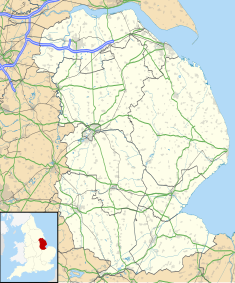Doddington Hall is, from the outside, an Elizabethan prodigy house or mansion complete with walled courtyards and a gabled gatehouse. Inside it was largely updated in the 1760s.[2] It is located in the village of Doddington, to the west of the city of Lincoln in Lincolnshire, England.
| Doddington Hall | |
|---|---|
 Doddington Hall | |
| Type | Prodigy house |
| Location | Doddington, Lincolnshire |
| Coordinates | 53°13′08″N 0°39′14″W / 53.219°N 0.654°W |
| Built | 1593–1600 |
| Built for | Thomas Taylor |
| Architect | Robert Smythson |
| Architectural style(s) | Elizabethan |
| Owner | Jarvis family[1] |
| Website | doddingtonhall.com |
Listed Building – Grade I | |
| Official name | Doddington Hall |
| Designated | 22 December 1983 |
| Reference no. | 1164612 |
Listed Building – Grade II* | |
| Official name | Gatehouse to Doddington Hall |
| Designated | 22 December 1983 |
| Reference no. | 1360505 |
Listed Building – Grade II* | |
| Official name | Walls and Gates to Doddington Hall |
| Designated | 22 December 1983 |
| Reference no. | 1061959 |
| Official name | Doddington Hall |
| Designated | 24 June 1985 |
| Reference no. | 1000975 |
History
editDoddington Hall was built between 1593 and 1600 by Robert Smythson for Thomas Tailor, who was a lawyer, the Recorder to the Bishop of Lincoln. It is a grade I listed building.[3] The facade is wide, but the house is only a single room deep at the centre.[4] In the 12th century the manor of Doddington was owned by the Pigot family who sold it to Sir Thomas Burgh in 1450, and eventually to John Savile of Howley Hall in Leeds. In 1593, he sold the manor house to Thomas Tailor who commissioned the present house. It was inherited by his son, and then his granddaughter Elizabeth Anton who married Sir Edward Hussey of Honington in Lincolnshire. Their son Sir Thomas Hussey inherited in 1658. Sir Thomas's three daughters were his co-heiresses when he died in 1706. Mrs Sarah Apreece was the surviving heiress and on her death in 1749, her daughter Rhoda, wife of Captain Francis Blake Delaval (the elder) of Seaton Delaval Hall in Northumberland, inherited. It then passed to her second son, Sir John Hussey-Delaval, and he had improvements made to the Hall in 1761 by Thomas and William Lumby of Lincoln. John's younger brother Edward Delaval inherited in 1808, and his daughter, Mrs Sarah Gunman, who inherited on her father's death in 1814, left the Hall to Lieutenant Colonel George Jarvis in 1829. On his death it passed to his cousin the Rev Robert Eden Cole, and it remains in private ownership today. In the mid 20th century the hall was restored by Laurence Bond and Francis Johnson.[5]
The hall's contents, including textiles, ceramics, porcelain, furniture and pictures, reflect 400 years of unbroken family occupation. In 1762, Sir John Hussey Delaval covered every inch of the Holly Room – even the back of the doors – with tapestries showing country scenes. The tapestries were made in Flanders in the early 17th century.
The hall and 6 acres (24,000 m2) of walled and wild gardens, with flowering from early spring until autumn, are open to the public, with facilities for private tours and school visits. A temple designed by Anthony Jarvis in 1973 stands in the gardens.[5] Summer concerts and occasional exhibitions are held in the Long Gallery. Other businesses have been developed on the estate such as the sale of Christmas trees, weddings, a bicycle shop with café and a farm shop.[6][7][8] Daniel Codd in Haunted Lincolnshire claims the hall is haunted.[9]
The parkland and gardens of Doddington Hall are listed Grade II* on the Register of Historic Parks and Gardens.[10]
Gallery
editExterior
edit-
East (Entrance) Front
-
West (Garden) Front
Interior
edit-
Entrance Hall
-
Main Stair (looking to the second floor)
-
Long Gallery
-
Brown Parlour
Gardens
edit-
West Garden
-
Temple of the Winds
References
edit- ^ "Doddington Hall". DiCamillo. Retrieved 11 August 2023.
- ^ Jenkins, 433
- ^ Historic England. "Doddington Hall (1164612)". National Heritage List for England. Retrieved 6 August 2011.
- ^ Jenkins, 433
- ^ a b Historic England. "Doddington Hall (1000975)". National Heritage List for England. Retrieved 6 August 2011.
- ^ "Peruse produce at Doddington Hall" Lincolnshire Echo 18 December 2004: 18. Newspaper Source Plus. Web. 29 December 2011.
- ^ "Festive decorations go back to nature." Lincolnshire Echo 18 December 2004: 18. Newspaper Source Plus. Web. 29 December 2011.
- ^ Caroline Donald. "True To Their Roots." The Sunday Times (8 March 2009): 22,23. Newspaper Source Plus. Web. 29 December 2011.
- ^ Codd, Daniel. Haunted Lincolnshire. Tempus Publishing Ltd (2006). p.28. ISBN 0-7524-3817-4
- ^ Historic England. "Doddington Hall (1000975)". National Heritage List for England. Retrieved 11 January 2017.
Sources
edit- Jenkins, Simon, England's Thousand Best Houses, 2003, Allen Lane, ISBN 0713995963
